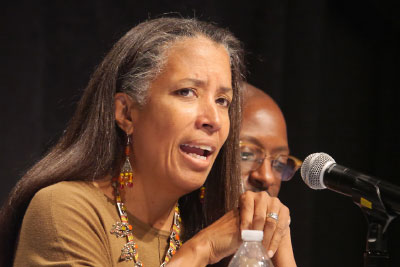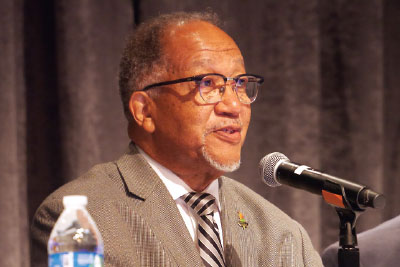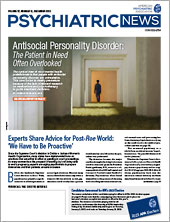“As a young man growing up in Washington D.C., I got trapped on a journey that stole many of my youthful years behind bars. … The courts, prosecutors, and probation officers prejudicially categorized me as a career criminal as a young man.”
—Timothy Thomas,
Founder of Fact Law Research LLC
“People in our jails and prisons are part of the community, and if we are going to call ourselves community mental health professionals, we have to understand the trauma and disruption in people’s lives [that come with] being in the criminal justice system.”
That’s what Stephanie Lemelle, M.D., M.S., director of public psychiatry education at Columbia University and the New York State Psychiatric Institute, said during a plenary session at this year’s Mental Health Services Conference on the role of mental health professionals in the criminal justice system.
Lemelle recalled her work as an associate director of a community mental health center. “Whenever we had clients who were new intakes into our program coming out of the criminal justice system, some of our clinicians said, ‘Oh we can’t take them—they’re too dangerous, they’re too acute. We’re not set up to treat them.’ So during one of our community meetings, I just asked our clients already in our program, by a show of hands, how many had ever been arrested or incarcerated. Half of the clients raised their hands. So I said to our clinicians and faculty, ‘Why are we saying no to these folks—these are our folks.’ ”
Lemelle said mental health professionals have responsibilities for helping individuals in their care avoid criminal justice involvement, advocating for individuals who are in the criminal justice system, and helping those who are re-entering the community from jails and prisons.
She was part of a panel that included Warren K. Graham, L.C.S.W., assistant dean of field education and a clinical assistant professor at Stony Brook University and a Ph.D. candidate at Adelphi University; Timothy Thomas, founder of Fact Law Research LLC, which specializes in providing legal research for defense attorneys; and Benjamin Chavis, D.Min., Ph.D., president and chief executive officer of the National Newspaper Publishers Association. The plenary was moderated by retired Ohio State Supreme Court Judge Evelyn Stratton, a member of the Board of Directors of the APA Foundation.
•
Community-based trauma and crisis care to prevent involvement with law enforcement.
•
The encounter with law enforcement.
•
Initial detention and court hearing.
•
Specialty court hearing (such as a mental health court).
•
Entry into jail or prison.
The booklet also includes general information about the criminal justice system and its processes, how to advocate for change, and a glossary of terms.
Stratton described the enormous growth of specialty court dockets—mental health courts, drug courts, and other courts with a therapeutic approach such as the
CATCH Court in Ohio, which deals with victims of human trafficking and women in prostitution.
“Back when I was a trial judge, we were all about punishment,” she said. “Fast forward to today with all of the specialized dockets across the country, I can tell you that judges everywhere say their specialized dockets are the best part of their job.”
So what can mental health professionals teach the nation’s judges and lawyers? “I would start by challenging the system to look at itself first,” said Graham. “In order to really do the work without bias, [judges and lawyers] need to look at how they have been socialized to understand mental illness and health and look at their own implicit biases.”
Then, he said, “judges need to understand that there is a deficit in their knowledge base about mental illness that does impact the people who come before them. That means learning what mental illness is and is not and learning about the progression of disease and how that shows up in the populations in front of them.”
Thomas, who had served long years in jails and prisons, was released in 2019. While incarcerated, he had taught classes, earned a paralegal degree, and helped lead a program to prevent recidivism among individuals who would be returning to society. After his release he founded Fact Law Research LLC.
He said judges, lawyers, and mental health professionals need to hear the voice of those with lived experience of the criminal justice system. “Although I am not a Ph.D. in the conventional sense, my life and that of many others who have endured long-term incarceration are classic case studies that [experts] constantly discuss when they seek to examine the factors that lead to criminal behavior,” Thomas said. “Since the ultimate goal is to find solutions to preventing [criminal behavior] and to direct an offender to a life within the mainstream of American society, then my input should be evaluated with the same level of courtesy” afforded policymakers and experts who lack lived experience.
“My story reveals a classic case study of escalating criminal behavior that was predictable by system authorities who seemed to care less about the path to crime and incarceration but more about incapacitation of young Black lives.”
Noting the severe shortage of mental health professionals willing to work in the criminal justice system, Stratton asked the panel how to attract young psychiatrists and mental health professionals to work in the system.
Chavis said newspapers and other media outlets need to tell more “good news” stories about mental health and illness (see box).
Lemelle called on everyone within the system to reflect on “how we got to where we are now with the over-incarceration of people of color and the over-incarceration of people with substance use disorders.”
She said, “Our society sees these individuals as people who are dangerous or morally weak or bad. I think we have to start with understanding our own biases and helping our young people who are interested in going into the field to understand that we have to undo that. We have to see every person as an individual and ask that person, ‘What is your story and what happened to you that you ended up in this situation?’ ”
“That is why we all went into the field,” Lemelle said. “Starting from that principle and trying to engage early career folks to check their biases at the door and really engage with [people in the criminal justice system] would be a way to get more people involved in working with these populations.” ■


